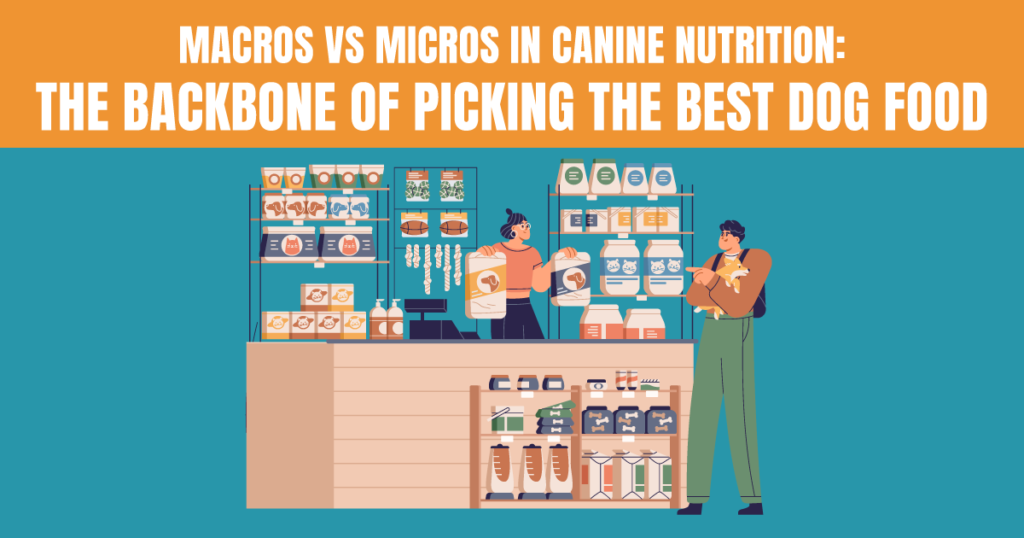We’ve all seen the dog food commercials where our dogs morph into wild wolves hunting down their tasty-looking prey. Slogans like meat, fancy protein sources, grain-free resources are very commonly found on the labels. But, is that all we need to look at? What about macros vs micros in canine nutrition? In the end, feeding a baby seems easier than finding the perfect food for our pup!

Canine Nutrition
To cut through the marketing jargon propelling the $42 billion U.S. pet food industry, you’ll need to have an understanding of the basics of macros vs micros in canine nutrition. Understanding (and then providing!) proper nutrition is one of the most important roles for pet parents. Nutrition is not only a foundation of daily dog gut health, but it’s also a key component of disease management. After all, there is the saying that food is medicine. But what is a nutrient? A nutrient is any food constituent that helps support life by being involved in all basic functions of the body, such as:
- Acting as a structural component
- Participating in chemical reactions
- Transporting substances
- Maintaining temperature, and
- Supplying energy
Every ingredient in your dog’s food contains different nutrients that help in digestion or serve as an energy source. These can be either macronutrients or micronutrients.
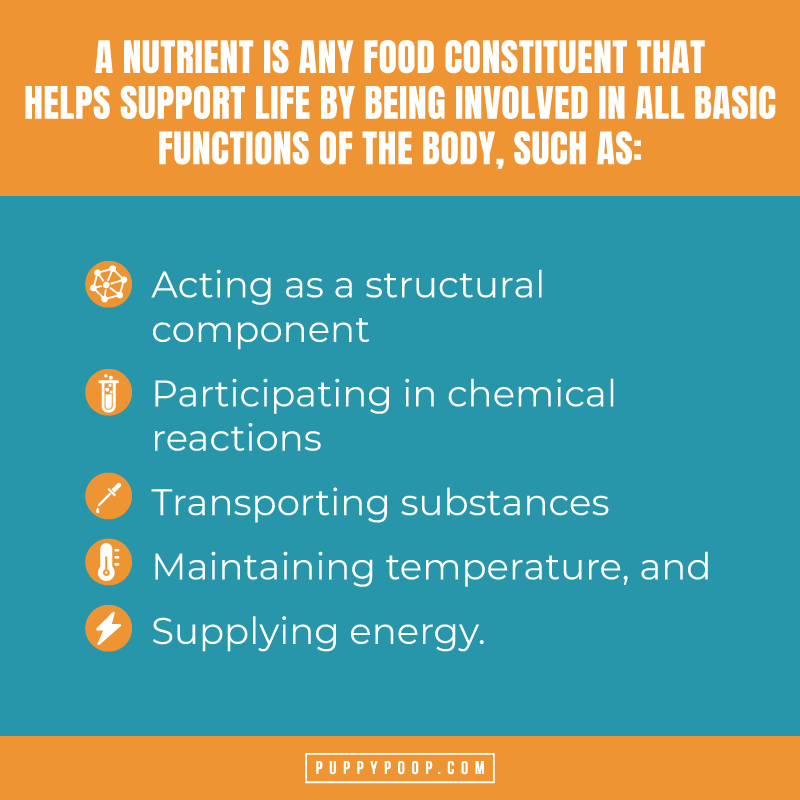
What Macros Do Dogs Need?
Macronutrients are the big building blocks of your dog’s nutrition. These nutrients include protein, fat, and carbohydrates. They supply your dog, a facultative carnivore, with the energy and structural elements for all of their systems.
Although whole books are dedicated to the subject, below is a quick overview of the three types of macronutrients:
Macronutrients: Protein for Dogs
Bodies use proteins for energy production, building and repairing muscles, and other body tissues. They are part of many bodily functions, including immune and hormonal functions. Amino acids are a critical part of your dog’s dietary needs. These amino acids can be found in protein. There are 20 different amino acids commonly found as protein components. Of these, dogs require 10 which are referred to as their essential amino acids. Sources of protein include meat and other animal products like eggs. Legumes, nuts, and whole grains also contain proteins.
As facultative carnivores, dogs rely on protein as the main component of their diet. Unlike cats who are true carnivores, their bodies can also process carbohydrates.
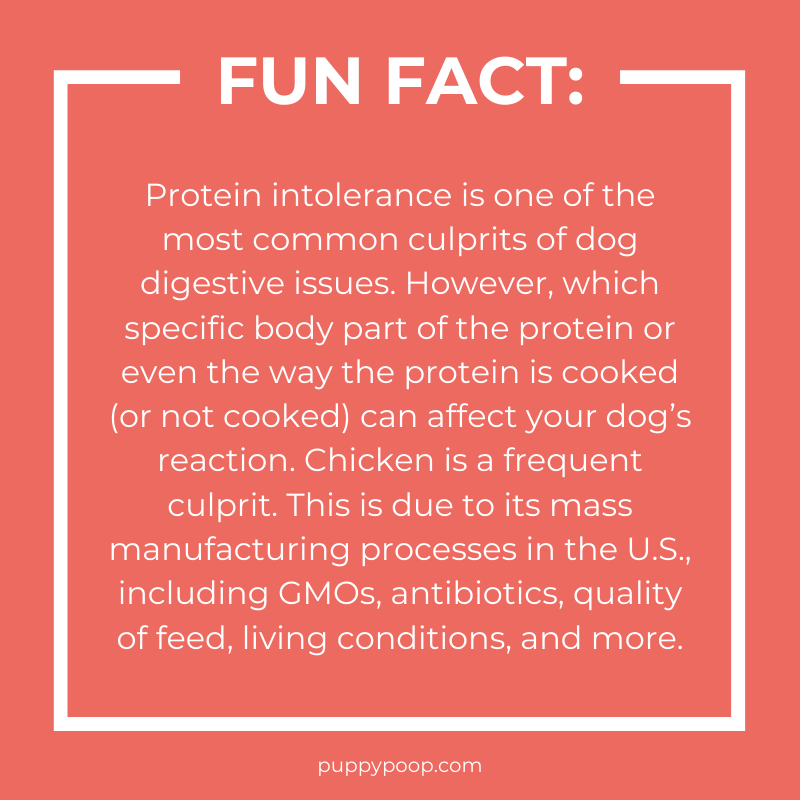
Macronutrients: Fat for Dogs
Lipids are made up of fatty chains. They have many functions in the body. These include supplying a lot of energy and cushioning organs. They also absorb fat-soluble vitamins and provide insulation. Sources of fat include the storage of fat from other animals, such as beef or fish. They also include seed oils from plants, such as sunflower oil. The wide range of fatty acid sources and profiles impact where fat is stored. It also affects the site of metabolism of these in your dog’s diet. In general, your dog will need a variety of fat sources to meet their physiological needs.
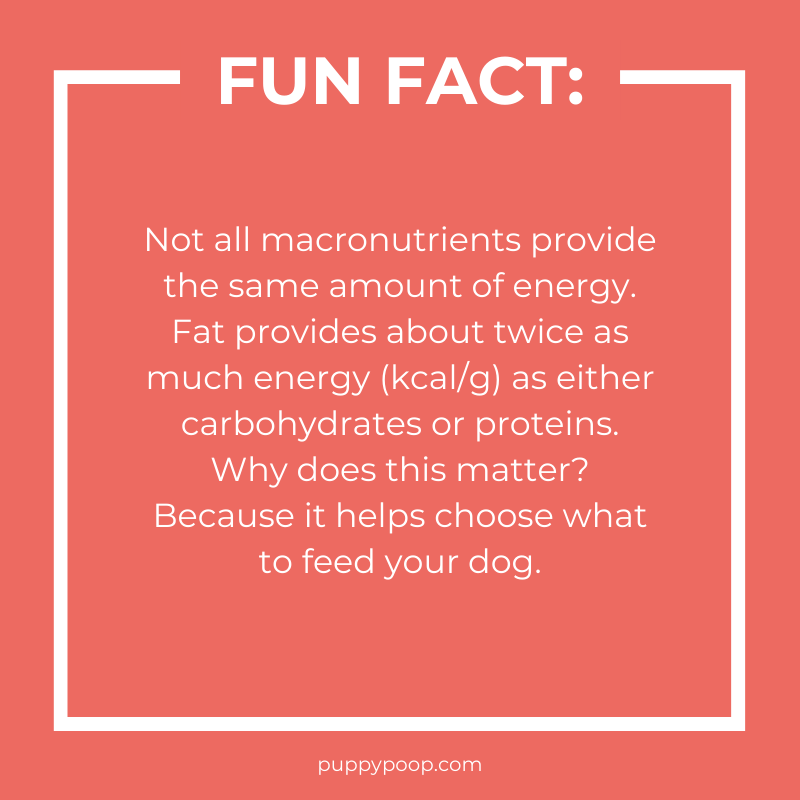
Macronutrients: Carbohydrates in Dog Food
Carbohydrates are also a source of energy for your dog. They can be found in whole grains, fruits, vegetables, beans, and more. It’s also important to mention that grain-free diets do not mean carbohydrate-free. In general, fiber is a nondigestible carbohydrate. It can’t be broken down into sugars, and is important in regulating blood sugar. Because fiber is nondigestible, it passes through the digestive tract whole. It gives your dog that satiated, full feeling, and regulates the digestion of food and bowel movements by managing water absorption. This is one of the reasons why you see sources of fiber, such as plain canned pumpkin, on almost every list of dog digestive problems remedies.
Ancestrally, the majority of a dog’s carbohydrate intake would be from eating digestive tracts of other animals. Mostly herbivore animals were the source. This would comprise less than 10% of their total diet. Natural fiber sources to keep dog digestive systems healthy include things that people might consider icky, such as fur and hair.

Water for dogs
Another important part of a dog’s diet is water. Although water is not an official macronutrient, it’s involved in nearly every body process. It regulates the body temperature, lubricates joints, and provides the fluid component of blood and cells. Providing adequate water may actually be one of the remedies to your dog’s digestive problems. Learn more about avoiding dog dehydration.
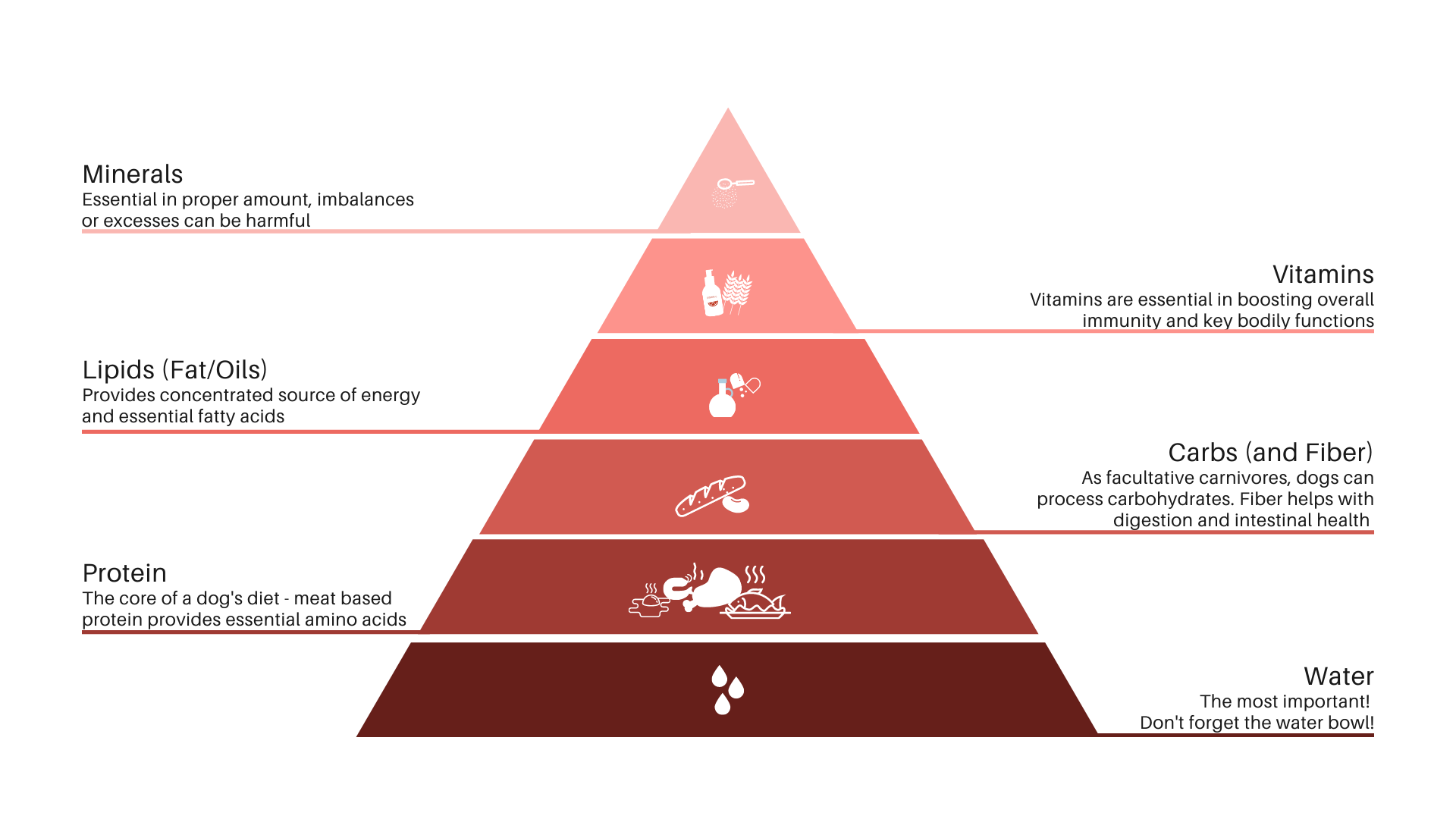
What Micros Do Dogs Need?
Next on the list of macros vs micros in canine nutrition is micronutrients. Micronutrients are the nutrients your dog needs in smaller amounts. However, just because your dog doesn’t need as much of these nutrients doesn’t mean they aren’t important. Many home-assembled meals can be more harmful than the commercial diets in the long run. They should be properly analyzed for micronutrients. Their main function is to support your dog’s various body functions. Though there are many nuances, micronutrients are categorized into two groups: vitamins and minerals.
Vitamins for Dogs
Vitamins play a part in immune function, energy production, blood clotting, and more. There are two classifications for vitamins: fat-soluble and water-soluble. Along with fats, your dog’s gut will absorb the fat-soluble vitamins. These include vitamins A, D, E, and K. Your dog’s body will typically absorb water-soluble vitamins by passive diffusion. They are needed on a more regular basis. These include vitamins B and C. (Note: unlike humans, dogs can synthesize vitamin C within their bodies).
Vitamins can be found naturally in all types of foods, especially whole fruits and vegetables. Your dog’s gut produces different types of bacteria as it digests Vitamins B and K. This is also another important function of the dog microbiome. For dogs eating a dry diet, different approaches are used to recover vitamins lost due to the harsh manufacturing and storage conditions. Vitamin deficiencies are rare because of the use of commercially prepared dog food.
Minerals for Dogs
Minerals are important for bone growth and repair, fluid balance, and cellular growth. They represent the inorganic part of the food. Inorganic materials are the elements that generally come from non-living sources.
Minerals can be part of plant and animal sources. The major minerals necessary to help dog digestion include calcium, phosphorus, sodium, chloride, potassium, magnesium, and sulfur. Trace minerals, like iron, copper, zinc, iodine, selenium, and others are important as well, just in smaller amounts.
Want a Healthy Dog? Focus on Variety Feeding
Remember, there is no such things as a perfect dog food. The best thing you can do for your dog’s nutrition is to provide a variety of high-quality foods.
Although pet food manufacturers would like you to believe this to be true, there is no one magical brand that will provide your dog with what they need their whole life. This is because macros vs micros in canine nutrition, and your dog’s body, are complex and ever-changing. Your dog’s nutritional needs change throughout their lifetime with factors like age. It also depends on the types of bacteria in dogs. Certain dog gut health conditions also play a key role in the required macros vs micros in canine nutrition.

Similar to managing our diet, the value of variety also extends to our dogs! We encourage you to try adding as much variety as you can – whether that includes mixing diet types, switching up brands on occasion, alternating recipes, or more.
Get the DIG Labs App
Download the free DIG Labs Digestive Health Tracker to get personalized insights and recommendations for your dog based on their stool.

